Top Business Carbon Footprint Tool for Enterprises
Karel Maly
June 14, 2025
Navigating the Landscape of Business Carbon Footprint Tools
Managing your business's carbon footprint is crucial for navigating increasing stakeholder pressure and evolving regulatory requirements, especially for complex enterprise supply chains. This listicle provides a detailed review of 12 leading business carbon footprint tools to help you choose the right solution. We'll go beyond simple feature lists and marketing jargon, providing practical insights based on real usage experience.
This comprehensive guide will equip you with the knowledge to:
- Identify the ideal business carbon footprint tool for your organization's specific needs
- Understand the strengths and weaknesses of each platform based on real-world use
- Implement your chosen tool effectively with practical implementation guidance
- Achieve your sustainability goals through accurate carbon accounting and informed decision-making
These tools are essential for measuring, analyzing, and ultimately reducing your environmental impact. We'll cover a range of solutions suitable for various needs, from initial carbon accounting to optimizing existing processes. The tools reviewed include Carbonpunk, CI3, s.r.o., Plan A, Position Green, Persefoni, Sweep, Watershed, Microsoft Sustainability Manager, Salesforce Net Zero Cloud, Sphera, Emitwise, and Greenly. This in-depth review offers invaluable insights for logistics and supply chain managers, Chief Sustainability Officers, ESG teams, compliance professionals, and environmental consultants working within enterprise organizations and specifically caters to the CZ region context. We focus on practical value and implementation guidance, providing you with the information you need to make the right choice.
1. Carbonpunk
Carbonpunk stands out as a sophisticated AI-powered business carbon footprint tool specifically designed for large enterprises grappling with complex supply chains. It streamlines the often cumbersome process of emissions tracking, analysis, and reporting. Direct integrations with logistics providers and easy CSV uploads simplify data collection, while AI-driven insights empower businesses to make impactful decisions.
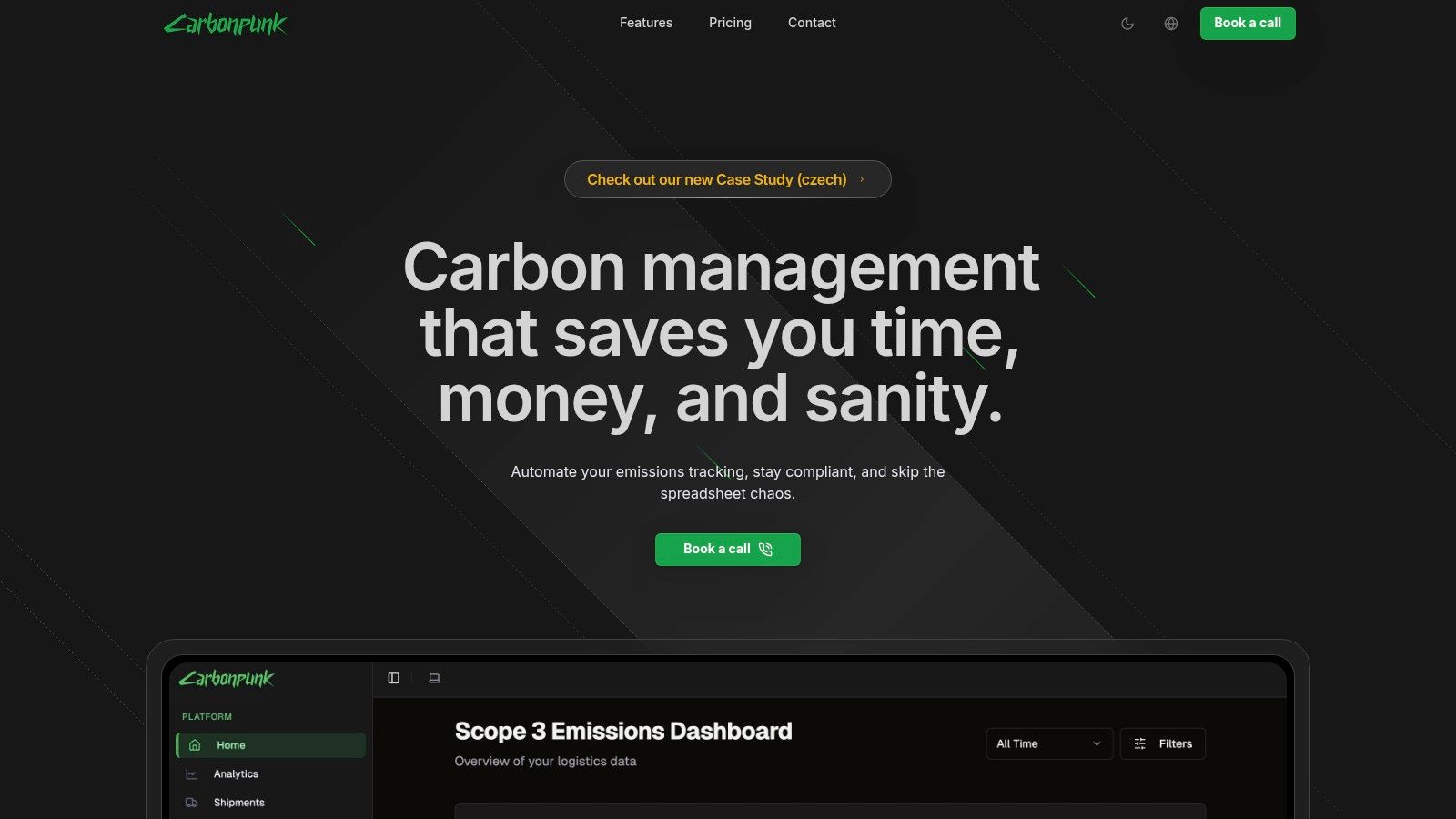
Carbonpunk boasts real-time CO2 emissions tracking with over 95% data accuracy, achieved through direct integrations and automated data validation. Learn more about Carbonpunk. This high level of precision offers a clear view of a company's environmental impact. Its AI-powered analytics engine goes beyond simple tracking, providing actionable recommendations for emissions reduction, such as route optimization and suggesting alternative transport modes. These features empower businesses to move from passive tracking to active emissions management.
Key Features & Benefits
- Automated ESG Reporting: Generate audit-ready reports aligned with GHG Protocol, TCFD, and CDP standards, ensuring effortless regulatory compliance.
- Customizable Dashboards: Monitor ongoing impact, access predictive forecasts, and benchmark against industry peers for strategic sustainability planning.
- AI-Driven Optimization: Unlock potential emissions reductions of up to 30% through intelligent route optimization and modal shift recommendations.
Pros & Cons
Pros:
- High data accuracy (over 95%) through real-time synchronization and validation
- AI-powered insights for optimizing delivery routes and transport modes
- Automated, compliant ESG reporting
- Robust data security protocols
Cons:
- Pricing requires direct consultation
- Primarily designed for complex enterprise supply chains, potentially not ideal for smaller businesses
Carbonpunk is a powerful tool for businesses seeking to gain a competitive advantage through strategic carbon management. While the need for direct pricing consultation might be a minor hurdle, the platform's sophisticated features and focus on actionable insights make it a compelling choice for organizations committed to measurable, scalable environmental impact. It transforms carbon footprint management from a compliance exercise into a strategic driver of cost savings and sustainability leadership.
2. CI3, s.r.o.
CI3, s.r.o. distinguishes itself as a leading provider of carbon footprint calculation services with a deep-rooted presence in the Czech Republic. As the sole accredited partner of the Carbon Disclosure Project (CDP) in the Czech Republic and Slovakia, CI3 offers specialized expertise in calculating corporate and product carbon footprints, coupled with comprehensive ESG consulting and decarbonization strategy development. This positions them as a valuable resource for businesses operating within these regions seeking to navigate the complexities of sustainability reporting and emissions reduction.
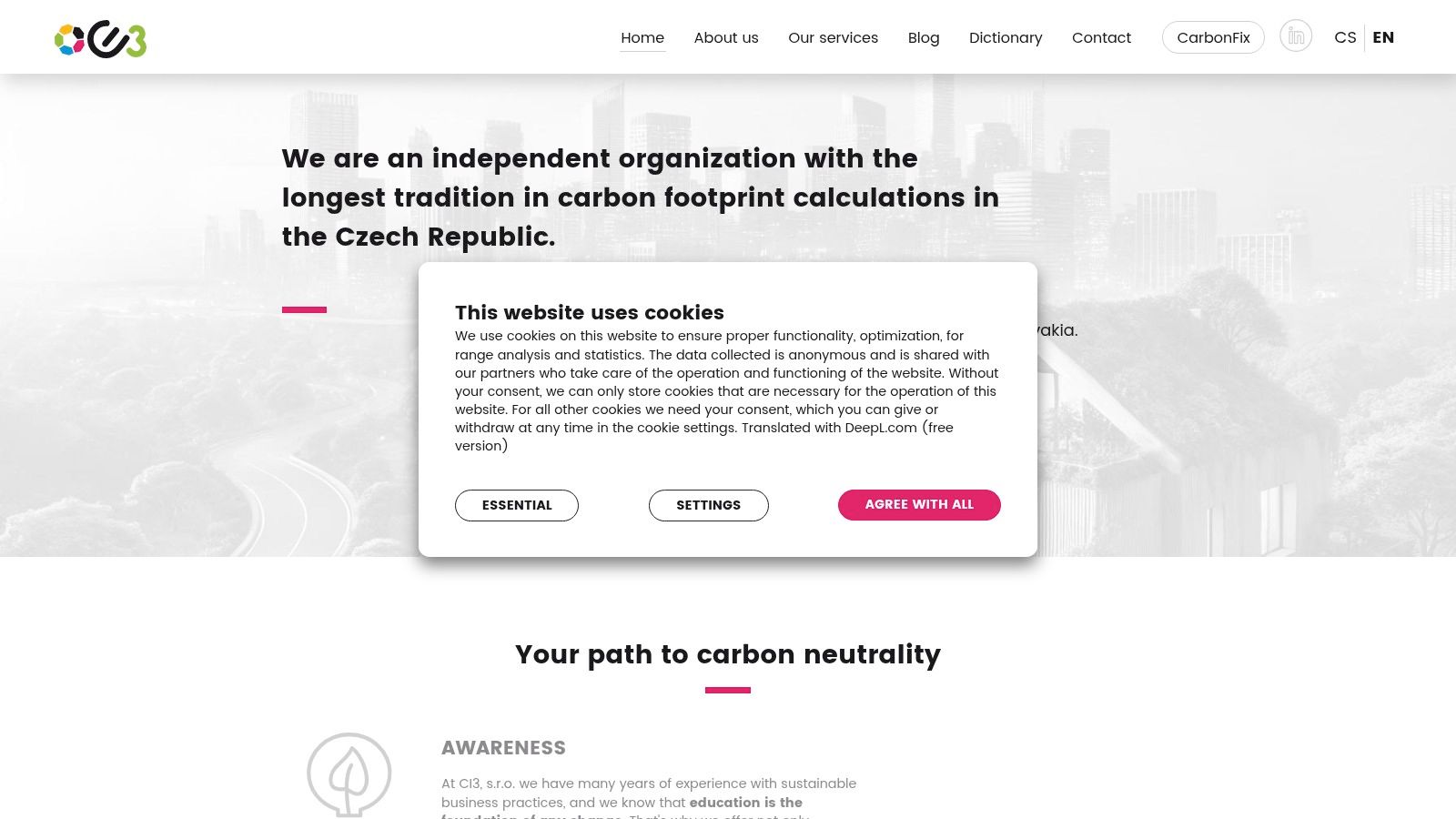
Their CarbonFix online calculator, grounded in the GHG Protocol, provides a practical tool for businesses to measure their environmental impact. Furthermore, CI3's personalized consulting approach ensures that clients receive tailored guidance and support throughout their sustainability journey. Their commitment to data quality and transparency reinforces the reliability and credibility of their services. This focus on accuracy and individualized support makes CI3 a valuable partner for organizations committed to robust carbon management.
Key Features & Benefits
- CarbonFix Online Calculator: User-friendly tool for calculating corporate and product carbon footprints.
- ESG Consulting: Comprehensive advisory services covering various aspects of environmental, social, and governance performance.
- Decarbonization Strategies: Development of tailored plans to help businesses reduce their emissions and achieve their sustainability goals.
- CDP Accredited Partnership: Recognized expertise in CDP reporting frameworks.
- Educational Resources: Seminars and workshops to enhance understanding of carbon footprint management and sustainability best practices.
Pros & Cons
Pros:
- Extensive local expertise in the Czech and Slovak markets.
- Personalized client support and guidance.
- Strong emphasis on data quality and transparency.
Cons:
- Services are primarily focused on the Czech and Slovak markets, potentially limiting applicability in other regions.
CI3 offers a valuable suite of tools and services for businesses seeking to address their carbon footprint and broader ESG performance. Their deep understanding of local regulations and reporting requirements, combined with their personalized approach, makes them a strong choice for organizations operating in the Czech and Slovak republics. While their geographic focus might be a limitation for some, their commitment to quality and transparency makes them a compelling partner for companies seeking a reliable and knowledgeable guide in their sustainability journey.
3. Plan A
Plan A offers a comprehensive carbon management platform tailored for European businesses, particularly relevant for those operating within the Czech Republic. This platform streamlines carbon accounting, reporting, and emissions reduction strategies, leveraging TÜV-certified tools. Plan A goes beyond basic tracking and provides personalized services and science-based solutions to drive effective decarbonization. This makes it a strong choice for companies seeking to align with tightening regulations and enhance their sustainability performance.
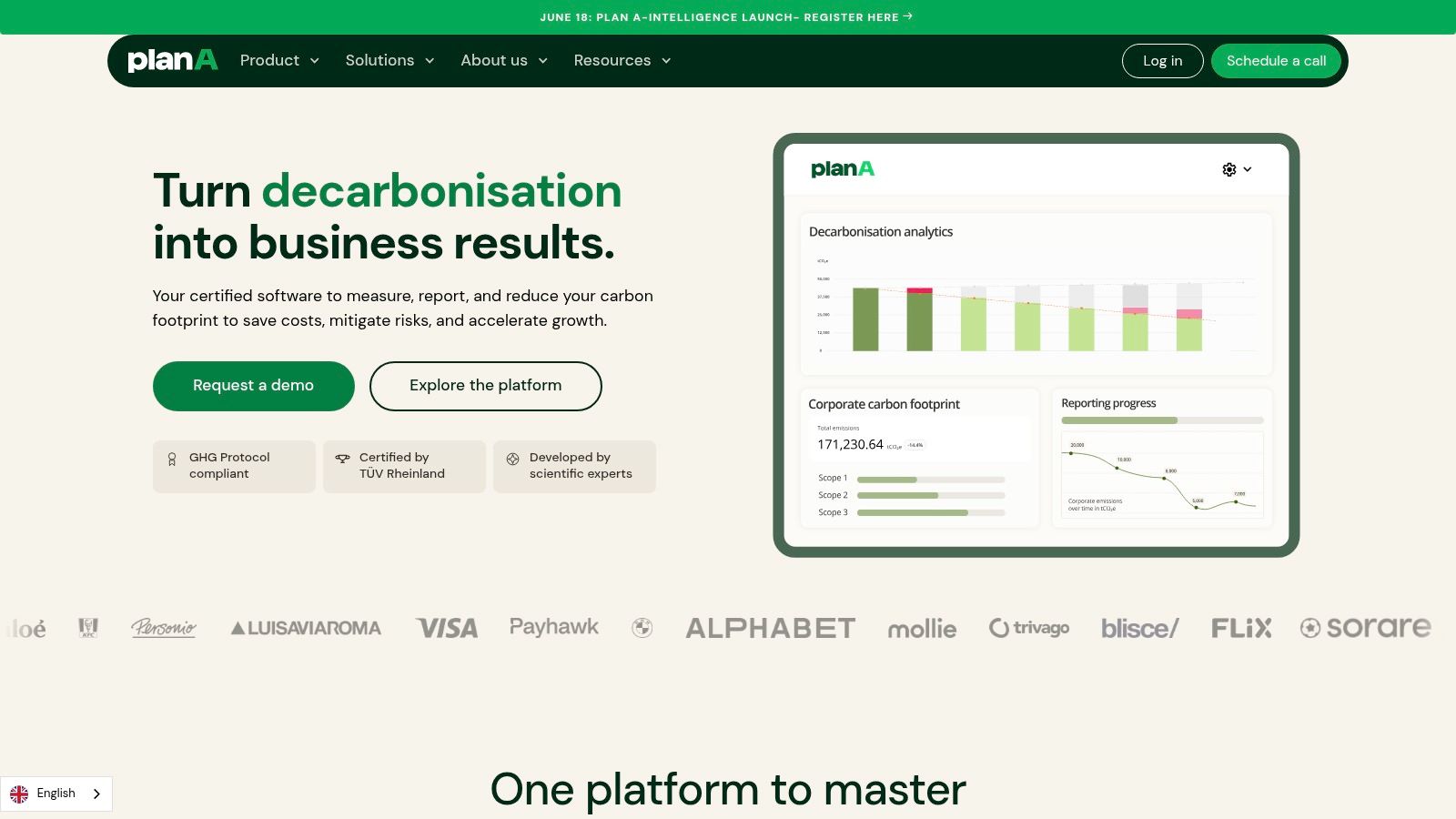
Plan A simplifies compliance with regulations such as the CSRD and other emerging standards. Its customizable dashboards and reporting features allow businesses to monitor their environmental impact effectively. The platform integrates with various data sources, facilitating data collection and analysis. This helps convert complex data into actionable insights for emissions reductions. Plan A's personalized support and expert guidance ensure businesses receive tailored strategies for their specific context.
Key Features & Benefits
- TÜV-Certified Carbon Accounting: Ensure accuracy and reliability in emissions calculations with internationally recognized standards.
- Decarbonization Action Plans: Develop and implement science-based strategies to reduce your environmental footprint.
- Regulatory Compliance Support: Navigate complex regulatory landscapes with tools and resources tailored to European and Czech requirements.
Pros & Cons
Pros:
- Strong focus on European regulations, making it highly relevant for businesses in the Czech Republic
- Personalized support and expert guidance for tailored decarbonization strategies
- Comprehensive approach to sustainability management, extending beyond basic carbon accounting
Cons:
- May require significant internal resources for initial implementation and ongoing management
Plan A transforms carbon footprint management from a compliance burden into a strategic opportunity. It empowers businesses in the Czech Republic to not only meet regulatory requirements but also to demonstrate leadership in sustainability. While implementing Plan A may require internal resource allocation, its comprehensive features and personalized support ultimately provide a solid foundation for long-term decarbonization success.
4. Position Green
Position Green offers a comprehensive ESG platform designed to integrate sustainability into every facet of a business. Its versatile feature set makes it a potential one-stop solution for companies, especially larger enterprises, navigating the complexities of ESG reporting and management. This platform helps streamline data collection and reporting, particularly valuable for businesses operating within the CZ region and subject to evolving EU sustainability regulations.
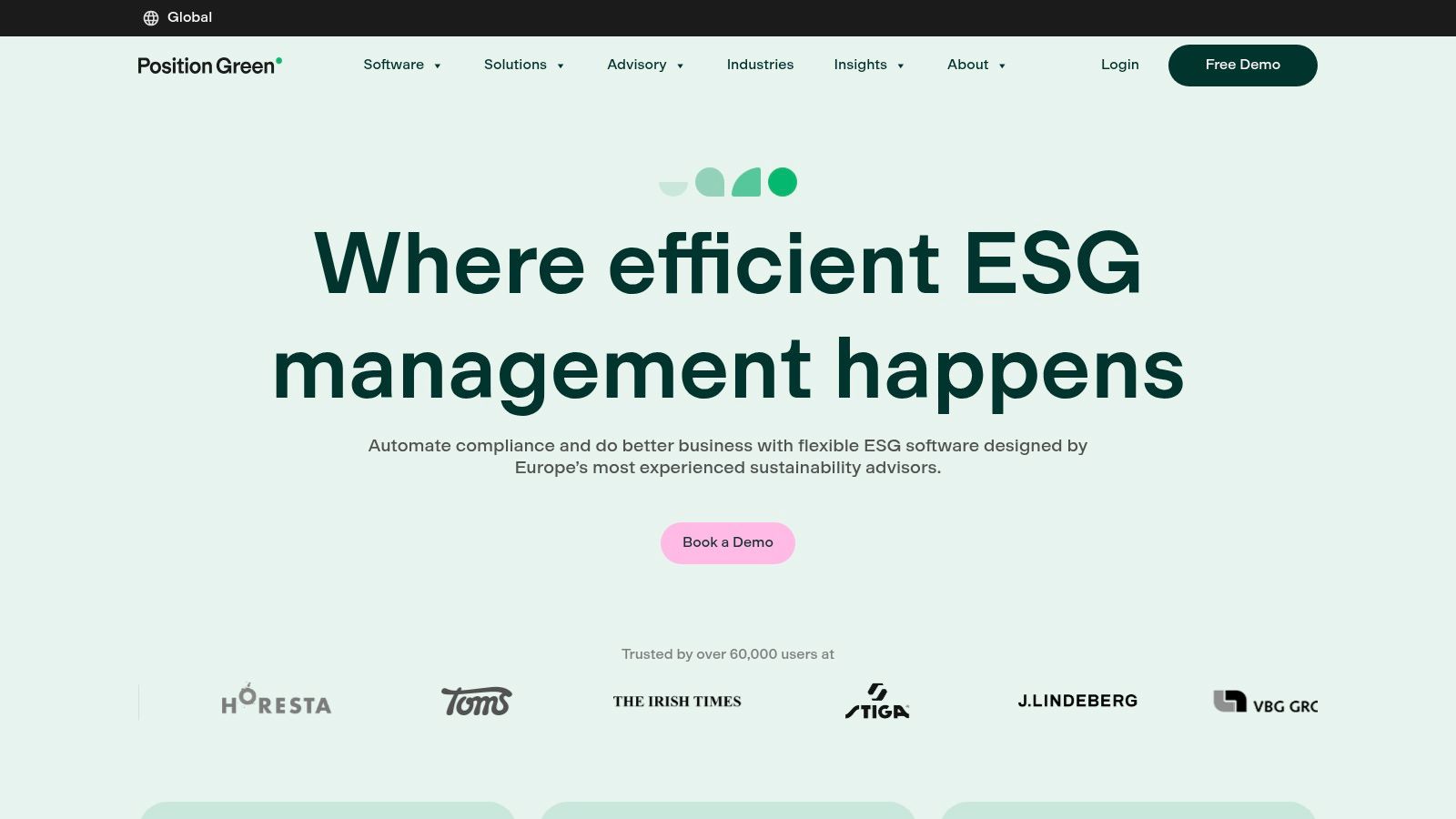
Position Green provides real-time visualization of emissions across Scopes 1, 2, and 3, offering a holistic view of a company's carbon footprint. The platform facilitates scenario planning for sustainability initiatives, enabling businesses to model the impact of various strategies. Seamless integration with existing systems minimizes disruption to established workflows. Critically, Position Green ensures compliance with ESRS, CDP, and other relevant frameworks, simplifying regulatory reporting for businesses in the CZ region.
Key Features & Benefits
- Real-time Emissions Tracking: Visualize emissions across all scopes, providing a comprehensive overview of your carbon footprint.
- Scenario Planning: Model the impact of different sustainability initiatives and make informed decisions.
- Regulatory Compliance: Simplify reporting with built-in support for ESRS, CDP, and other frameworks.
- Dynamic Dashboards: Centralized data management and visualization for actionable insights.
Pros & Cons
Pros:
- User-friendly interface accessible to organizations at various stages of ESG maturity.
- Comprehensive toolset covering a wide range of sustainability management needs.
- Strong emphasis on regulatory compliance, crucial for businesses in the CZ region.
Cons:
- Full feature set may be more suitable for larger organizations with complex ESG requirements.
- Pricing information not readily available, requiring direct contact.
Position Green empowers businesses to move beyond basic carbon accounting towards proactive ESG management. While potentially better suited for larger organizations, its comprehensive features and regulatory compliance focus make it a valuable business carbon footprint tool, particularly for companies in the CZ region facing increasing ESG scrutiny. Its ability to integrate with existing systems and provide dynamic, real-time insights allows businesses to transform ESG data into actionable strategies.
5. Persefoni
Persefoni is an AI-powered carbon measurement and reporting platform designed to help businesses measure, report, and actively reduce their carbon footprint. It offers assurance-grade emissions reporting compliant with major climate disclosure regulations and provides tools for advanced decarbonization strategies. This makes it a robust solution for large enterprises and financial institutions seeking comprehensive carbon management. For those specifically looking to tackle Scope 3 emissions, exploring resources like this guide on Scope 3 emissions tracking can provide valuable insights. Learn more about Persefoni.
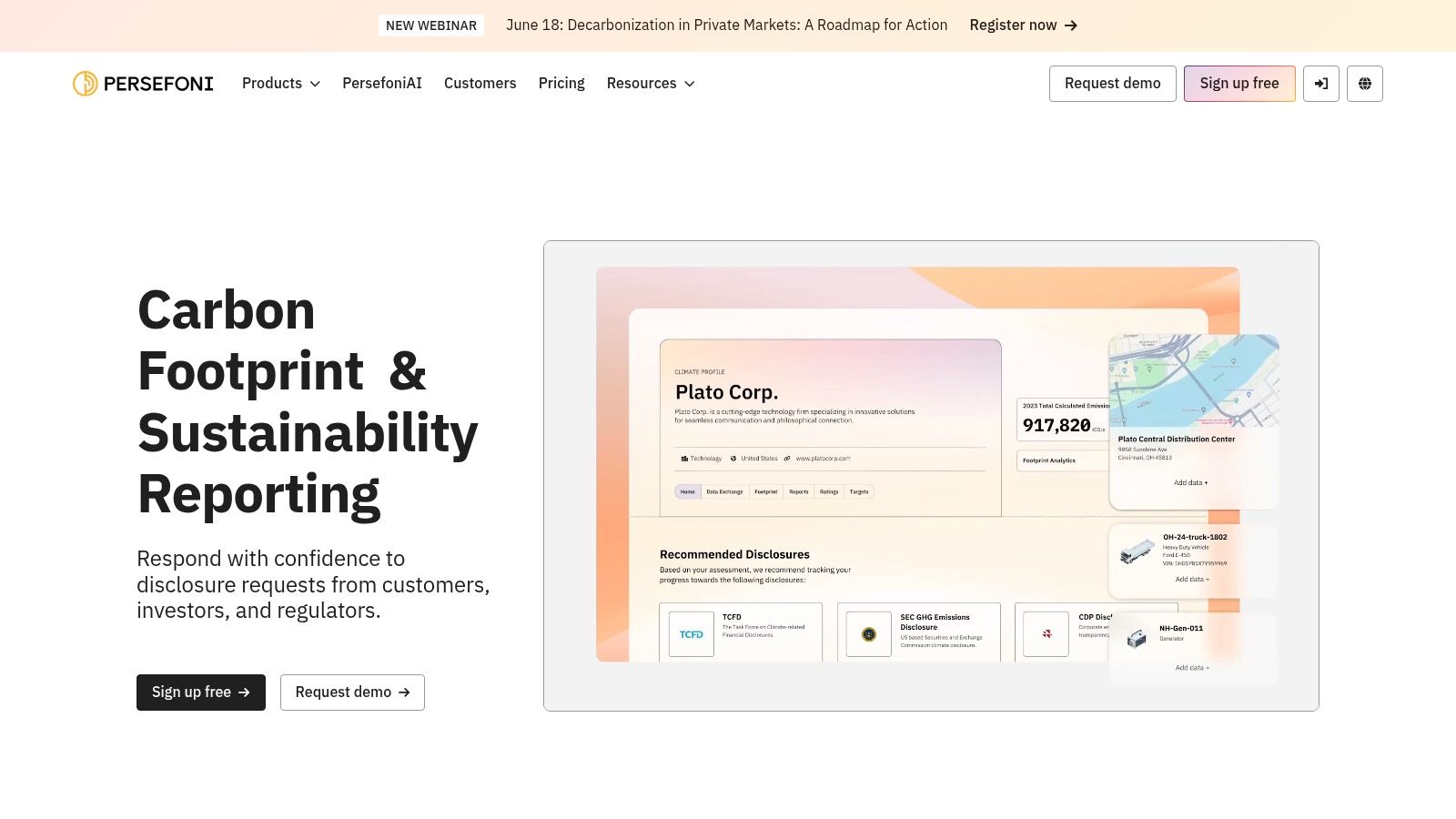
Persefoni leverages AI to analyze complex data sets, offering a granular view of emissions across the value chain. This includes Scope 3 supplier engagement features, enabling businesses to collaborate with their suppliers on emissions reduction initiatives. Furthermore, its integration capabilities with existing financial and operational systems streamline data collection and reporting processes. This comprehensive approach empowers businesses to move beyond basic reporting towards proactive carbon management.
Key Features & Benefits
- AI-Driven Measurement & Reporting: Automates data collection and analysis, providing accurate and auditable emissions data.
- Regulatory Compliance: Supports reporting aligned with global standards such as GHG Protocol, TCFD, and CDP.
- Decarbonization Management: Offers tools for setting reduction targets, tracking progress, and identifying opportunities for improvement.
Pros & Cons
Pros:
- Advanced AI capabilities for in-depth data analysis.
- Comprehensive reporting aligned with international standards.
- Robust supplier engagement features for collaborative emissions reduction.
Cons:
- Complexity may pose implementation challenges for smaller businesses.
- Pricing information is not readily available and requires direct consultation.
Persefoni presents a powerful solution for organizations committed to robust carbon accounting and active decarbonization. Its AI-powered insights and comprehensive reporting capabilities position it as a valuable tool for achieving ambitious sustainability goals. While its complexity might make it more suitable for larger enterprises, its potential for driving meaningful change in carbon management makes it a compelling option.
6. Sweep
Sweep offers a scalable business carbon footprint tool designed for organizations at any stage of their sustainability journey. Its intuitive interface and robust supplier engagement tools make it a standout choice, particularly for those with complex supply chains seeking to effectively manage Scope 3 emissions. Sweep helps streamline data collection and analysis, providing actionable insights for emissions reduction.
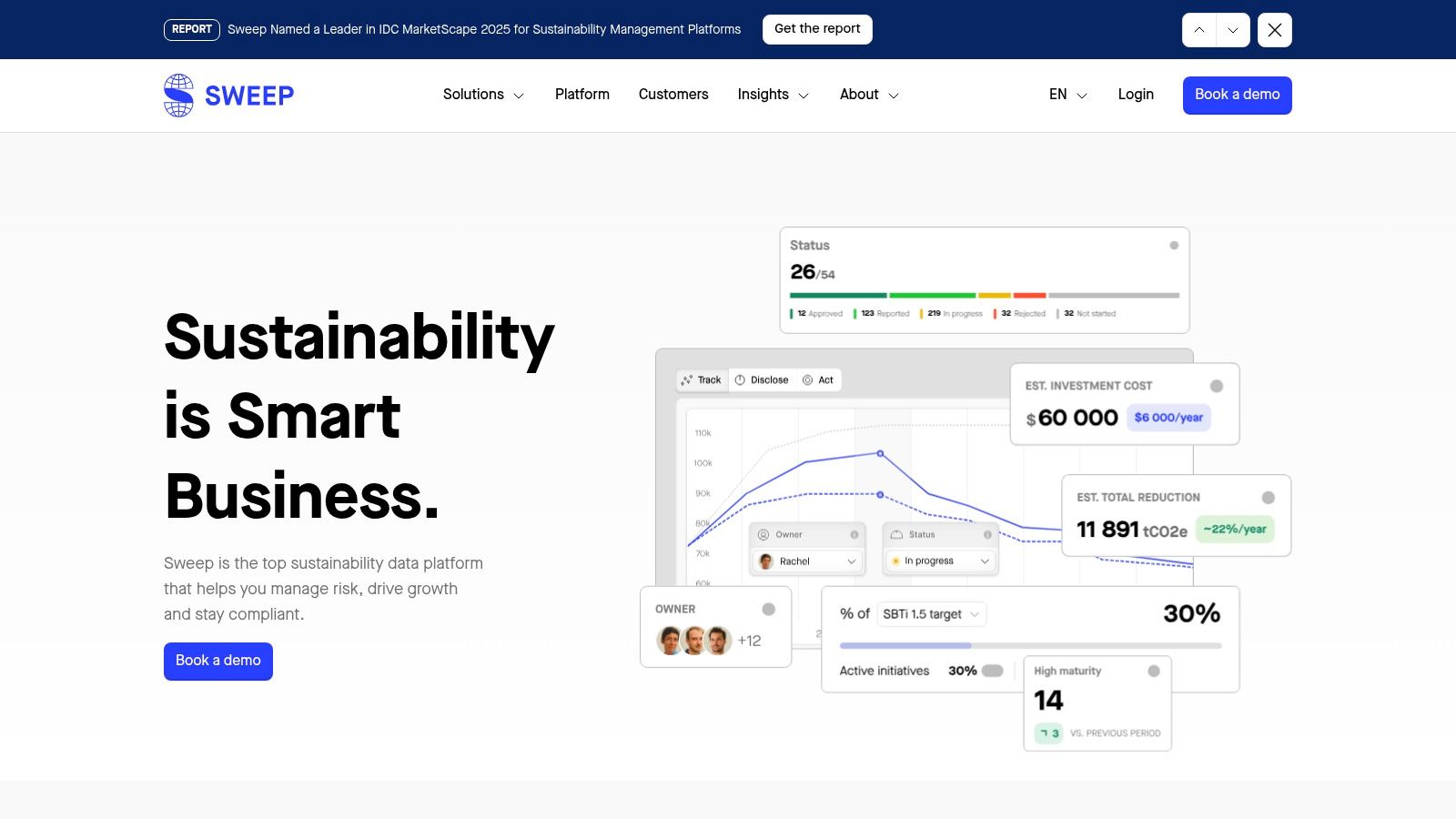
One of Sweep's strengths lies in its focus on collaboration. The platform facilitates engagement with suppliers, enabling them to easily input their emissions data. This collaborative approach simplifies Scope 3 emissions tracking, a notoriously challenging aspect of carbon accounting. Sweep's flexible visualization tools and scenario planning features further empower businesses to model different reduction strategies and track progress towards their targets.
Key Features & Benefits
- Comprehensive Scope 3 Tracking: Streamlines the often complex process of gathering and analyzing emissions data from your supply chain.
- Supplier Engagement Tools: Empowers suppliers to directly contribute emissions data, fostering collaboration and increasing data accuracy.
- Scenario Planning: Model the impact of various emissions reduction initiatives to identify the most effective strategies.
Pros & Cons
Pros:
- User-friendly interface simplifies carbon accounting processes.
- Strong focus on supply chain emissions (Scope 3).
- Suitable for businesses of all sizes, from SMEs to large enterprises.
Cons:
- Integrating Sweep with existing systems may be necessary to unlock its full potential. This can require some initial setup and configuration.
Sweep offers a powerful solution for businesses seeking to take control of their carbon footprint, particularly those grappling with complex supply chain emissions. Its collaborative features and focus on actionable insights transform carbon management from a compliance burden into a strategic opportunity. While integration with existing systems might require some effort, the long-term benefits of improved data accuracy and streamlined reporting make Sweep a worthwhile investment. Learn more about Sweep.
7. Watershed
Watershed offers a comprehensive emissions management solution, combining advanced data analysis with expert guidance. It's designed for large enterprises seeking to deeply integrate climate action within their supply chains. Watershed excels at tracking emissions across every stage of the value chain, offering granular insights often missed by simpler tools. This makes it particularly valuable for companies with complex, global operations looking to gain a true understanding of their environmental impact.
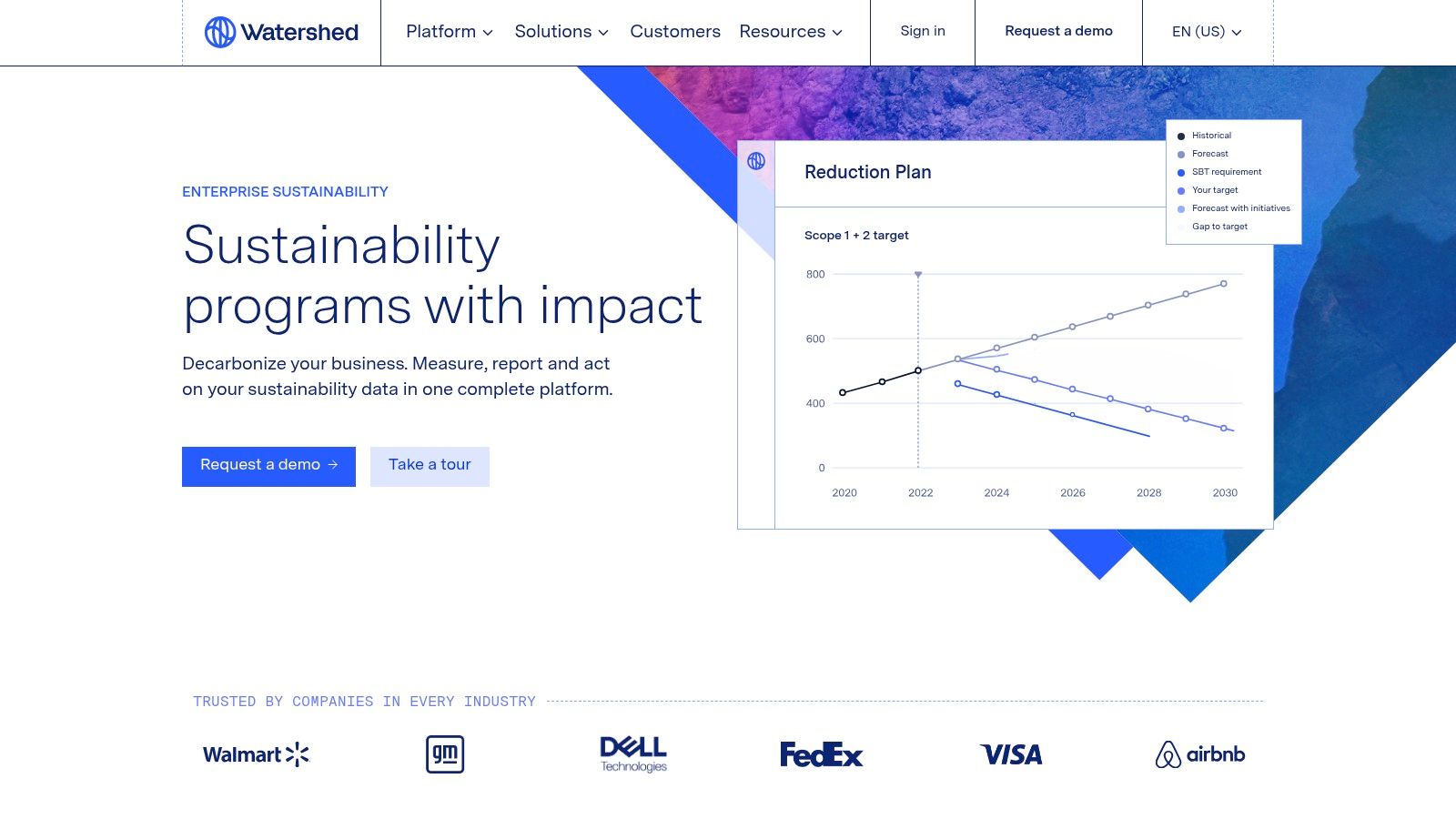
Watershed goes beyond basic carbon accounting by connecting emissions data with financial and operational systems. This integrated approach empowers businesses to align their corporate strategies with science-based targets. The platform also provides access to a carbon removal marketplace, facilitating direct investment in verified offset projects. Its investor-grade reporting features ensure compliance with evolving regulatory requirements and stakeholder expectations.
Key Features & Benefits
- Supply Chain Integration: Track emissions from Scope 1, 2, and 3 sources, achieving comprehensive visibility across the entire value chain.
- Science-Based Targets: Develop and track progress against ambitious emissions reduction goals aligned with the latest climate science.
- Carbon Removal Marketplace: Directly support vetted carbon removal projects to offset unavoidable emissions and invest in innovative climate solutions.
Pros & Cons
Pros:
- Deep supply chain integration provides a holistic view of emissions.
- Advanced tools facilitate strategic alignment with sustainability goals.
- Investor-grade reporting ensures transparency and regulatory compliance.
Cons:
- Implementation can be resource-intensive, requiring significant data integration and internal alignment.
- Pricing is not publicly available, necessitating direct consultation with the Watershed team.
Watershed transforms carbon footprint management from a compliance exercise into a strategic driver of value creation. While the implementation process may require upfront investment, the platform's robust features and expert support empower businesses to build a resilient, sustainable future. Its focus on deep integration and actionable insights positions it as a valuable tool for businesses seeking to lead the transition to a low-carbon economy. Learn more about Watershed.
8. Microsoft Sustainability Manager
Microsoft Sustainability Manager offers an enterprise-grade solution for tracking and managing environmental impact. It integrates seamlessly within the Microsoft ecosystem, making it a natural fit for businesses already leveraging Microsoft products. The platform provides real-time tracking of energy usage and emissions, offering valuable visibility into a company's carbon footprint and facilitating data-driven decision-making. This integration allows for streamlined data collection and analysis, particularly valuable for organizations already utilizing platforms like Azure and Dynamics 365.

Microsoft Sustainability Manager’s strength lies in its data management capabilities. It provides robust reporting tools aligned with various regulatory frameworks, simplifying compliance and reporting processes. The platform’s scalability makes it suitable for large enterprises with complex data needs. Its data governance features ensure data security and integrity, crucial for accurate tracking and reporting. For CZ businesses, Microsoft's established presence and robust support network offer additional advantages.
Key Features & Benefits
- Real-Time Energy Tracking: Monitor energy consumption and emissions data across your operations for immediate insights.
- Robust Reporting Tools: Generate comprehensive sustainability reports aligned with global standards, simplifying compliance.
- Microsoft Ecosystem Integration: Seamlessly integrates with existing Microsoft tools, enhancing data flow and analysis.
Pros & Cons
Pros:
- Excellent integration with other Microsoft products, streamlining workflows.
- Comprehensive data analysis and reporting capabilities for informed decision-making.
- Scalable architecture to accommodate the needs of large enterprises.
Cons:
- Businesses not invested in the Microsoft ecosystem might find the platform less advantageous.
- Pricing details are not readily available, requiring direct consultation.
Microsoft Sustainability Manager transforms complex environmental data into actionable insights. While its close ties to the Microsoft ecosystem might limit its appeal for some businesses, it provides a powerful, integrated solution for organizations already leveraging Microsoft's suite of products. Its robust features, combined with its focus on data security and compliance, position it as a valuable business carbon footprint tool for enterprises seeking to effectively manage their environmental impact.
9. Salesforce Net Zero Cloud
Salesforce Net Zero Cloud is a comprehensive carbon accounting and sustainability management platform built for large enterprises. It aims to streamline emissions tracking, reporting, and reduction efforts, all within the familiar Salesforce ecosystem. This makes it particularly attractive for businesses already leveraging Salesforce CRM and other cloud offerings. It centralizes environmental data management, enabling organizations to gain a holistic view of their carbon footprint.
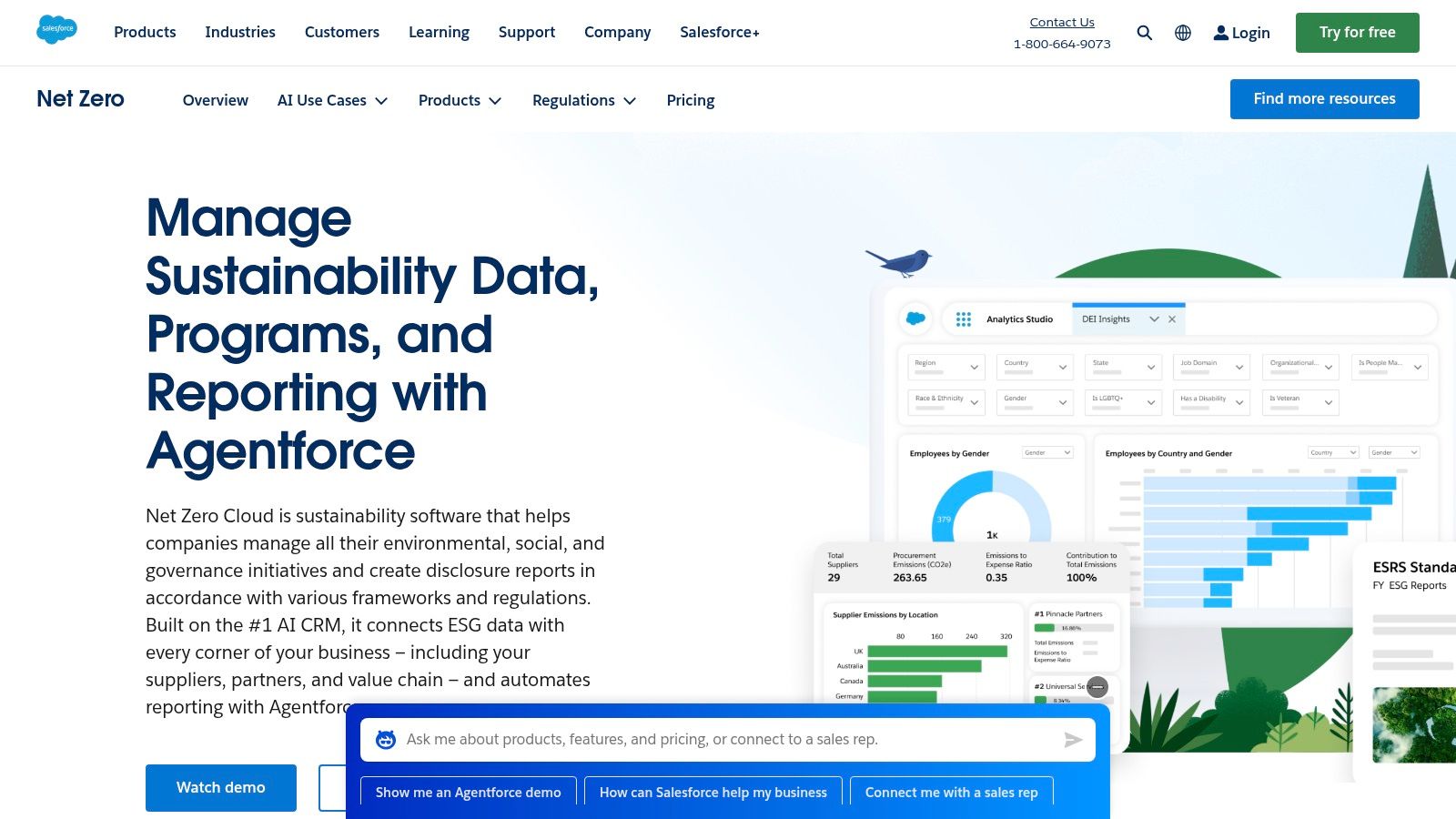
Net Zero Cloud helps businesses move beyond basic carbon accounting. Its scenario planning and forecasting tools enable informed decision-making for emissions reduction strategies. The platform's integration with Salesforce CRM facilitates data collection from across the value chain, including supplier emissions. This integrated approach offers a significant advantage for organizations seeking a unified view of their environmental performance. Furthermore, the platform provides tools for managing carbon offsets and ensuring compliance with evolving regulations.
Key Features & Benefits
- Integrated Carbon Footprint Tracking: Track Scope 1, 2, and 3 emissions across your entire value chain.
- Supplier Engagement: Assess and manage supplier sustainability performance.
- Scenario Planning: Model the impact of different emissions reduction strategies.
- Automated Reporting: Generate compliant ESG reports aligned with various frameworks.
Pros & Cons
Pros:
- Seamless integration with the Salesforce ecosystem.
- Robust data analysis and reporting capabilities.
- Comprehensive suite of sustainability management tools.
Cons:
- Tight integration with Salesforce can be a drawback for organizations using different CRM platforms.
- Pricing may be prohibitive for smaller businesses.
Salesforce Net Zero Cloud empowers businesses to proactively manage their environmental impact. Its deep integration with the Salesforce platform provides a strong foundation for organizations already invested in this ecosystem. While its complexity and potential cost may be less suitable for smaller businesses, larger enterprises seeking a robust, unified sustainability management solution will find it a valuable tool for driving significant environmental progress. It enables companies to transition from reactive reporting to strategic carbon management within a centralized, data-driven platform.
10. Sphera
Sphera offers a comprehensive suite of tools for corporate sustainability, including a robust business carbon footprint tool. It's designed for large organizations needing to measure Scope 1, 2, and 3 emissions across complex operations and global supply chains. Sphera goes beyond basic carbon accounting, integrating risk management and product lifecycle analysis for a holistic sustainability approach.

From experience, Sphera's strength lies in its ability to connect emissions data with broader ESG performance. This allows businesses to identify environmental risks and opportunities across their entire value chain. Its detailed analytics provide insights for strategic decision-making, going beyond simple reporting requirements. Sphera's platform facilitates collaboration across departments and suppliers, crucial for accurate data collection and effective emissions reduction strategies.
Key Features & Benefits
- Advanced Analytics: Explore emissions trends, identify hotspots, and model reduction scenarios.
- Sustainability & Risk Management: Integrate emissions data into overall ESG and risk assessments.
- Strong Compliance Features: Generate reports aligned with various regulatory frameworks, including GRI, SASB, and TCFD.
- Supply Chain Mapping: Gain visibility into upstream and downstream emissions for a complete carbon footprint picture.
Pros & Cons
Pros:
- Comprehensive solution covering various aspects of corporate sustainability.
- Strong focus on risk management, linking environmental performance to business strategy.
- Suitable for a wide range of industries, from manufacturing to finance.
Cons:
- Can be complex to implement and requires dedicated resources for setup and ongoing management.
- Pricing is not publicly available, requiring direct consultation.
Sphera provides a powerful business carbon footprint tool that's particularly valuable for large enterprises with complex operations. Its integration of risk management and product lifecycle assessment makes it a strategic choice for companies looking to embed sustainability into their core business strategy. While the implementation might require significant upfront investment, the platform's comprehensive features offer a robust solution for long-term carbon management and broader ESG performance. Learn more about Sphera
11. Emitwise
Emitwise offers a comprehensive carbon management platform designed for enterprises navigating the complexities of Scope 3 emissions. Its strength lies in automating data processing with machine learning, empowering businesses to make data-driven procurement decisions for a more sustainable supply chain. This focus makes it especially valuable for companies grappling with extensive and often opaque supplier networks.
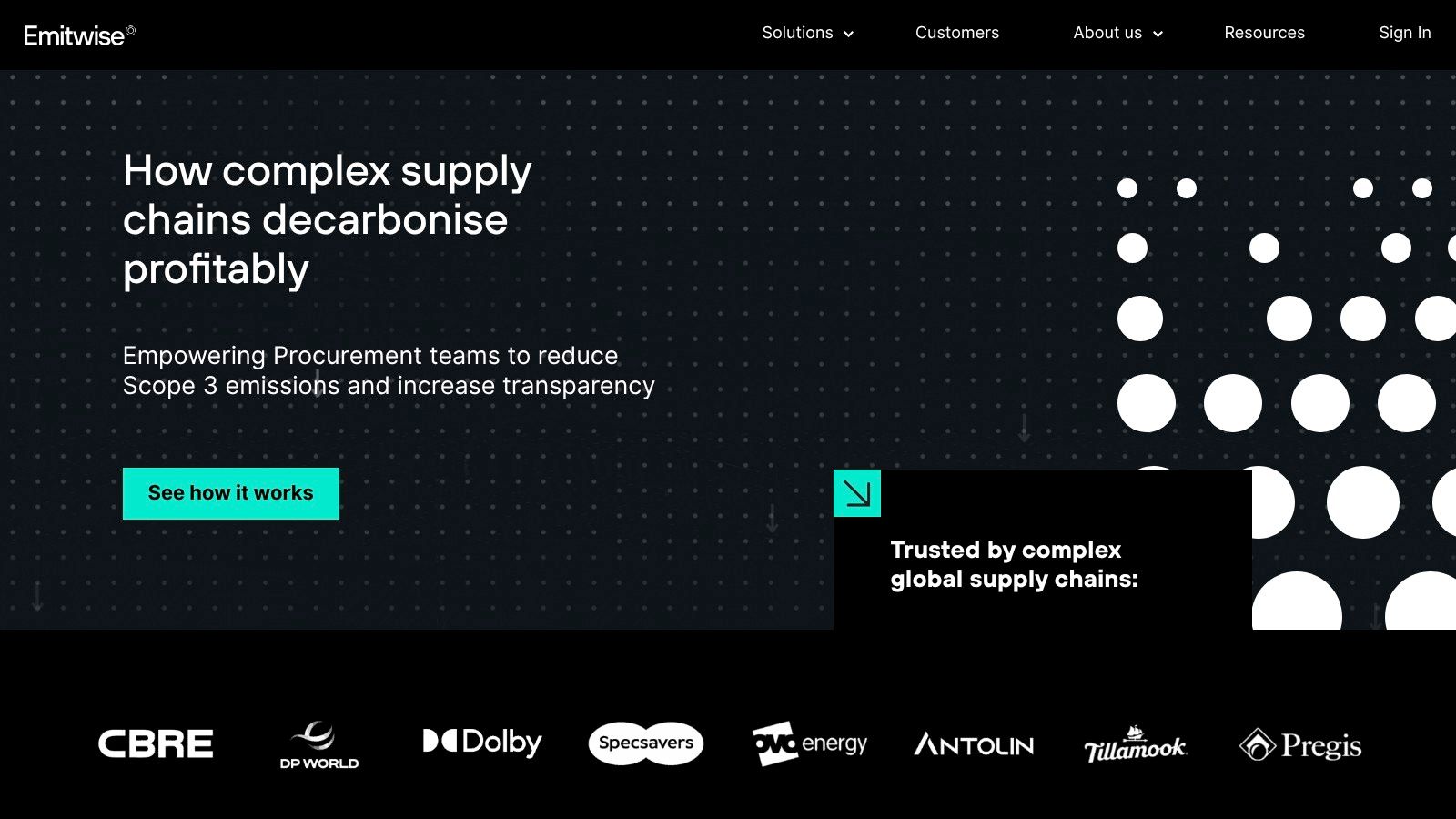
Emitwise shines in its ability to delve deep into supply chain emissions, often a significant yet challenging area for businesses. Its AI-powered engine automatically categorizes and calculates emissions from purchased goods and services, providing granular insights previously difficult to obtain. This automated approach streamlines data collection and reporting, enabling businesses to efficiently track progress towards reduction targets. Learn more about Emitwise. The platform’s focus on sustainable procurement provides valuable data for informed supplier selection and engagement, driving positive change throughout the value chain.
Key Features & Benefits
- Scope 3 Emission Management: Automate the collection and analysis of complex Scope 3 emissions data.
- Supply Chain Engagement: Facilitate collaboration with suppliers to gather emissions data and drive collective reduction efforts.
- Sustainable Procurement: Make informed purchasing decisions based on supplier emissions data, supporting a greener supply chain.
Pros & Cons
Pros:
- Powerful machine learning for automated emissions calculations
- Comprehensive Scope 3 coverage
- Actionable insights for sustainable procurement
Cons:
- Implementation can require significant internal resources
- Pricing not publicly available, requiring direct consultation
Emitwise provides a valuable tool for businesses seeking to understand and reduce their environmental impact, especially within their supply chains. While the initial setup may require some dedicated effort, the platform's advanced capabilities and focus on data-driven decision-making make it a strong contender for enterprises committed to true supply chain sustainability. It empowers businesses to move beyond basic carbon accounting and actively engage in building a greener future.
12. Greenly
Greenly positions itself as a user-friendly carbon management platform ideal for small to medium-sized businesses (SMBs) looking to measure, manage, and reduce their carbon footprint. Its automated data collection and personalized action plans simplify the complexities of carbon accounting, enabling businesses to focus on tangible emission reduction strategies. The platform also emphasizes employee engagement, fostering a company-wide commitment to sustainability.

Greenly excels at simplifying carbon accounting by automating data collection from various sources. It connects to accounting software, utility providers, and travel management platforms, minimizing manual data entry. This streamlined process saves considerable time and resources, especially for businesses with limited ESG expertise. The platform also offers personalized recommendations based on the collected data, guiding businesses towards practical emission reduction actions.
Key Features & Benefits
- Automated Data Collection: Integrates with various data sources for seamless tracking of emissions.
- Personalized Action Plans: Provides tailored recommendations to guide businesses towards effective emission reduction strategies.
- Employee Engagement Tools: Empowers employees to participate in sustainability initiatives and track their individual impact.
Pros & Cons
Pros:
- User-friendly interface simplifies carbon management for businesses of all sizes.
- Strong focus on employee engagement promotes a company-wide commitment to sustainability.
- Suitable for small to medium-sized businesses with limited ESG resources.
Cons:
- May lack the advanced features and customization options required by larger enterprises with complex supply chains. Direct integration with logistics providers, for example, might be limited compared to tools designed for larger operations.
Greenly provides an accessible entry point for businesses embarking on their carbon management journey. Its focus on simplicity and employee engagement makes it a valuable tool for SMBs. While it may not offer the same depth of features as enterprise-grade solutions, its user-friendly approach effectively empowers businesses to understand and manage their environmental impact. For organizations in the CZ region looking for a straightforward yet comprehensive carbon accounting solution, Greenly offers a strong foundation for building a sustainable future. Learn more about Greenly.
Top 12 Business Carbon Footprint Tools Comparison
| Platform | Core Features / Capabilities | User Experience / Quality ★★★★✩ | Value Proposition 💰 | Target Audience 👥 | Unique Selling Points ✨ | Price Points 💰 |
|---|---|---|---|---|---|---|
| Carbonpunk 🏆 | Real-time CO₂ tracking, AI analytics, audit-ready ESG reports | ★★★★★ 95%+ accuracy, real-time sync | High emission reduction (20-30%), cost saving | Large enterprises, logistics & ESG teams | AI-driven insights, compliance ease, custom dashboards, secure | Consultation-based, enterprise pricing |
| CI3, s.r.o. | Carbon footprint calc., ESG consulting, decarbonization plans | ★★★★ Local expertise, personalized service | Deep local market expertise | Czech & Slovak companies | Accredited CDP partner, education seminars | Not publicly disclosed |
| Plan A | TÜV-certified tools, decarbonization strategies, compliance | ★★★★ Personalized support, dashboard options | Science-based, regulation-focused | European businesses, mid-to-large firms | TÜV certification, CSRD compliance | Not publicly disclosed |
| Position Green | Emission visualization, scenario planning, compliance | ★★★★ User-friendly, dynamic dashboards | Comprehensive ESG management | Businesses at all ESG stages | Real-time Scope 1-3 visualization, regulatory support | Not publicly disclosed |
| Persefoni | AI carbon measurement, regulatory reporting, decarbonization | ★★★★ Advanced AI, global standards aligned | Investor-grade reporting, AI-driven analysis | Large enterprises, finance sectors | Scope 3 supplier engagement, deep integrations | Not publicly disclosed |
| Sweep | Scope 3 tracking, supply chain engagement, scenario planning | ★★★★ Intuitive, supplier collaboration tools | Scalable, supply chain focused | Varied business sizes | Flexible visualization, strong supply chain focus | Not publicly disclosed |
| Watershed | Footprint tools, SBT setting, carbon removal marketplace | ★★★★ Deep supply chain integration | Science-based target alignment | Large enterprises | Carbon removal marketplace, investor-grade reporting | Not publicly disclosed |
| Microsoft Sustainability Manager | Real-time energy tracking, strong MS integration | ★★★★ Seamless Microsoft ecosystem integration | Enterprise-grade, scalable | Large enterprises using Microsoft stack | Data governance, MS product native | Not publicly disclosed |
| Salesforce Net Zero Cloud | Carbon tracking, supplier assessments, CRM integration | ★★★★ Salesforce ecosystem integration | Integrated CRM & sustainability | Large enterprises using Salesforce | Cloud analytics, offset management | Not publicly disclosed |
| Sphera | Advanced analytics, risk mgmt, compliance | ★★★★ Comprehensive & industry-diverse | Risk & sustainability combined | Large organizations | Supply chain mapping, product sustainability | Not publicly disclosed |
| Emitwise | Scope 3 management, ML automation, procurement | ★★★★ Advanced ML, supply chain focus | Machine learning driven | Complex supply chains | Strong supplier engagement, CDP & SBTi alignment | Not publicly disclosed |
| Greenly | Automated data, action plans, employee engagement | ★★★ User-friendly, SMB focused | Time-saving, employee-driven | Small to medium businesses | Employee tools, quick reporting | Not publicly disclosed |
Making the Right Choice for Your Business
Navigating the landscape of business carbon footprint tools can feel overwhelming. This detailed overview of 12 leading platforms provides a solid foundation for your selection process. From established players like Sphera and Microsoft Sustainability Manager to innovative solutions like Sweep and Emitwise, each tool offers unique strengths and caters to specific needs. Remember, choosing the right tool is the first step toward effective carbon management.
Key Takeaways for Supply Chain Decarbonization
Several key themes emerged throughout this exploration of business carbon footprint tools. Data integration is paramount, especially for complex supply chains. Look for solutions that seamlessly connect with your existing ERP, CRM, and other relevant systems. Scalability is also crucial, ensuring the tool can grow alongside your organization's evolving needs. Finally, consider the level of support and training offered. Robust onboarding and ongoing assistance can make a significant difference in successful implementation.
Choosing the Best Fit for Your Enterprise
The "best" business carbon footprint tool depends entirely on your specific requirements. For large multinational corporations with complex supply chains operating in the CZ region and beyond, platforms like Salesforce Net Zero Cloud or Persefoni might be suitable due to their advanced analytics and reporting capabilities. Smaller businesses or those focused on specific emission scopes might find tools like Greenly or Plan A more appropriate.
Consider these factors when making your decision:
- Industry: Some tools specialize in certain sectors, offering tailored features and calculations.
- Supply Chain Complexity: Evaluate the tool's ability to handle the intricacies of your particular supply chain.
- Reporting Requirements: Ensure the tool aligns with the reporting frameworks relevant to your business and region.
- Budget: Pricing models vary significantly, from subscription-based services to usage-based fees.
- Integration Capabilities: Seamless data integration is critical for accurate and efficient carbon accounting.
Implementing Your Chosen Tool: Practical Considerations
Implementing a business carbon footprint tool is not a "set it and forget it" task. It requires careful planning and ongoing management. Secure buy-in from key stakeholders across your organization. Establish clear roles and responsibilities for data collection, analysis, and reporting. Regularly review and update your data to ensure accuracy. Finally, leverage the insights provided by the tool to drive meaningful reductions in your environmental impact.
Embracing a Sustainable Future in the CZ Region and Beyond
The increasing focus on environmental responsibility in the CZ region and globally underscores the importance of accurate carbon accounting. By investing in a robust business carbon footprint tool, you're not simply complying with regulations. You're making a strategic investment in a more sustainable future. You're empowering your organization to optimize resources, minimize its environmental footprint, and gain a competitive edge in the growing green economy. The right tool can transform your carbon footprint from a compliance burden into a driver of innovation and growth. Don't just track your emissions - actively manage them and contribute to a greener world.
Ready to streamline your carbon accounting and empower your sustainability journey? Explore how Carbonpunk, a cutting-edge business carbon footprint tool, can help your enterprise achieve its environmental goals. Visit Carbonpunk today to learn more.